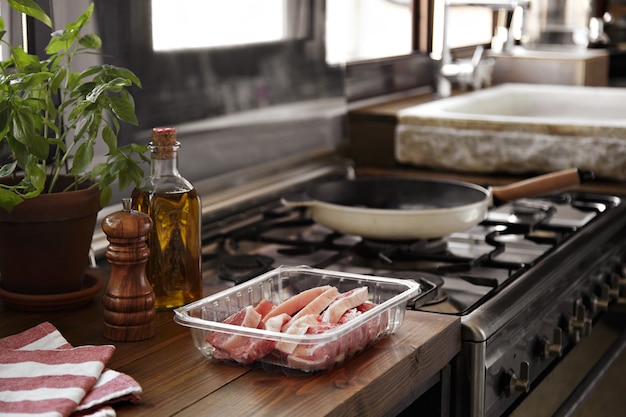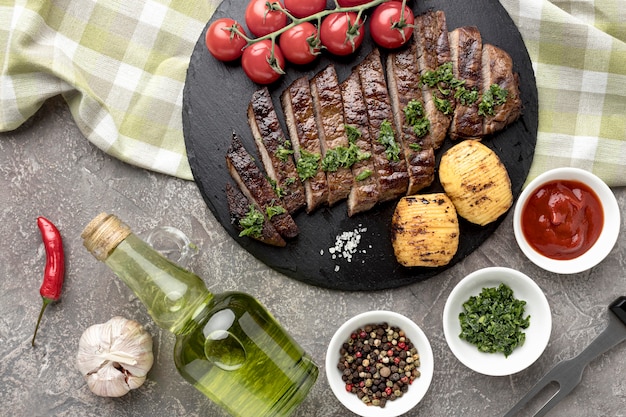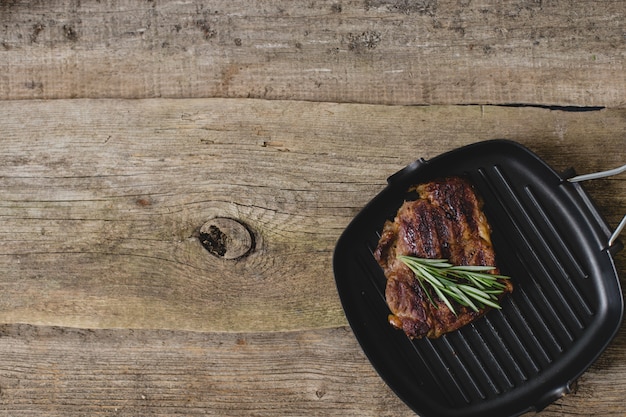Remember those days when I'd shy away from flat iron steak? It just didn't seem as glamorous as those fancy ribeyes and filets. But let me tell you, my perspective completely changed after discovering the delicious potential of this often overlooked cut. I realized that a flat iron steak, cooked just right, could compete with any other cut in terms of flavor and tenderness. The trick, as with most things in life, lies in the details.
So, what makes flat iron so great? It's packed with flavor thanks to its beautiful marbling, it’s a lot easier on the wallet than those pricey cuts, and it's incredibly versatile – perfect for grilling, pan-searing, or, as we’ll explore today, baking to perfection in the oven.
(Part 1) Choosing the Right Flat Iron

You know what they say, a journey of a thousand miles begins with a single step. In this case, that first step is choosing the right flat iron steak. It all starts with understanding the importance of quality.
The Importance of Quality
Think of it this way, you wouldn’t settle for just any ingredients for your favorite recipe, right? Same goes for the flat iron. Look for a steak that has a nice even color, good marbling, and a firm texture. The marbling is crucial, as it’s the fat that gives the steak its flavor and tenderness.
Getting Expert Advice
Don't be afraid to ask your butcher for advice. They are the experts, after all! They can point you towards the best flat iron in the shop, and they'll even trim it for you if you ask nicely. You know, a bit of friendly banter never hurts!
Thickness: A Crucial Factor
We're talking oven cooking here, so thickness matters. You want a steak that’s at least 1 inch thick. If it’s thinner, it’ll cook too quickly and might end up dry. It’s all about finding that perfect balance.
Now, don’t get discouraged if you’ve got a thinner steak, we’ll cover how to handle those in a later part.
(Part 2) The Prep Work: Setting the Stage for Success

Alright, we've chosen our flat iron, now it's time to get ready for the show. Just like a good chef prepping their ingredients, we need to set the stage for success.
Bringing It Up to Room Temperature
This step is often overlooked, but it's worth the effort. Take your flat iron out of the fridge and let it sit at room temperature for about 30 minutes. This lets the steak warm up evenly, ensuring that it cooks more consistently and avoids becoming tough or rubbery. It’s like giving it a chance to unwind before the heat hits!
Seasoning: The Essence of Flavor
Now for the fun part – seasoning! I'm a firm believer in keeping it simple with salt and pepper. A generous sprinkle of both, really allowing those flavors to coat the steak. I like to use coarse salt for that extra bit of texture and a deeper flavor.
Timing is Everything
Here’s a tip: Season the steak about 30 minutes before you plan to cook it. This gives the salt time to penetrate the meat and draw out some of the moisture, resulting in a more flavorful and tender steak. Think of it as a little salt therapy for your flat iron.
(Part 3) Cooking Your Flat Iron Steak to Perfection in the Oven

We're in the home stretch now, ready to transform that flat iron into a culinary masterpiece. It's all about mastering the heat and timing.
The Oven: Your Culinary Companion
Preheat your oven to 400°F (200°C). A hot oven is key for a beautiful sear on the outside and a perfectly cooked interior. Think of it as creating that initial burst of flavor, locking in the juices.
Searing: The Art of Creating a Crispy Crust
Now, for that irresistible sear, my go-to is a trusty cast iron skillet. It distributes heat evenly and gives you those beautiful grill marks. It’s a classic combination that works wonders.
Heat the skillet over medium-high heat for a couple of minutes. You want it hot, but not smoking. Carefully place your steak in the pan and let it cook for about 3-4 minutes per side. Don’t move it around too much, let it get a nice crust before flipping. This is where patience comes in handy.
Finishing in the Oven: Achieving Even Cook
Transfer your beautifully seared steak to a baking sheet. Slide it into the preheated oven and let it cook for about 10-12 minutes for a medium-rare steak. Remember, every oven is different, so you might need to adjust the cooking time.
To make sure your flat iron is cooked to your liking, use a meat thermometer. Here’s a handy guide:
| Doneness | internal temperature (°F) |
|---|---|
| Rare | 125-130 |
| Medium-Rare | 130-135 |
| Medium | 140-145 |
| Medium-Well | 150-155 |
| Well-Done | 160 |
Remember, the temperature will continue to rise slightly after you take the steak out of the oven. So, aim for a temperature that’s just a little below your desired doneness.
(Part 4) The Importance of Rest
Alright, your flat iron is cooked to perfection! Now, don’t rush into slicing it up. Let it rest for 10 minutes before you do anything else. This might seem like forever, but trust me, it’s crucial. It allows the juices to redistribute throughout the steak, resulting in a more tender and flavorful cut.
(Part 5) Thin Flat Irons: A Quick Fix
We’ve all been there, sometimes you end up with a thinner flat iron steak. Don’t worry, it’s not a disaster! You just need to adjust your approach a bit.
Since thinner steaks cook quickly, you’ll want to skip the searing step and cook them directly in the oven. Place the steak on a baking sheet and bake at 400°F (200°C) for about 6-8 minutes for medium-rare.
As always, check for doneness with a meat thermometer and let it rest for a few minutes before slicing and serving.
(Part 6) Beyond the Basics: Taking Your Flat Iron Steak to the Next Level
Alright, we’ve covered the fundamentals. Now it’s time to get creative! The flat iron steak is a canvas for your culinary imagination.
Flavoring Your Steak: Unleashing the Flavors
Let’s explore a world of possibilities beyond just salt and pepper. The flat iron steak is incredibly versatile and lends itself well to a variety of seasonings and marinades.
- Herbs and Garlic: For a classic touch, try a rub of fresh rosemary, thyme, and oregano, combined with minced garlic. It's a simple but effective combination that enhances the natural flavors of the steak.
- Citrus and Spices: Add a zesty kick with a mix of lemon or lime zest, paprika, cumin, and chili powder. The citrus brightens the flavors, while the spices add depth and warmth.
- Asian-Inspired: Embrace the bold flavors of Asian cuisine with a marinade of soy sauce, ginger, garlic, and sesame oil. This marinade infuses the steak with a delicious umami flavor.
- Sweet and Spicy: For a sweet and spicy twist, combine brown sugar, paprika, cayenne pepper, and a touch of garlic. This rub creates a sweet, smoky, and spicy flavor profile that’s sure to impress.
Marinades: Deepening the Flavor Profile
If you’re feeling adventurous, you can take your flat iron steak to another level with a marinade. It infuses the meat with flavor from the inside out, creating a more complex and delicious result.
Here’s a simple, but flavorful marinade recipe:
Ingredients:
- 1/2 cup soy sauce
- 1/4 cup olive oil
- 2 tablespoons honey
- 1 tablespoon grated ginger
- 2 cloves garlic, minced
- 1 teaspoon black pepper
Instructions:
- Combine all ingredients in a bowl and whisk until well combined.
- Add your steak to a resealable bag and pour the marinade over it.
- Refrigerate for at least 2 hours, or even better, overnight. This allows the flavors to fully penetrate the meat.
- Remove the steak from the marinade and pat it dry with paper towels before cooking.
(Part 7) Serving Up Your Flat Iron Steak: The Perfect Accompaniments
The flat iron steak is ready, now let’s create the perfect supporting cast to showcase its star power. It's all about finding those perfect accompaniments.
side dishes: Complementary Flavors and Textures
Your flat iron steak is the hero of the dish, but let's give it a strong supporting cast! Here are a few ideas for side dishes that will complement and enhance the flavors of your steak.
- Roasted Vegetables: Roast some asparagus, Brussels sprouts, or broccoli for a healthy and flavorful side. The roasting process brings out their natural sweetness and creates a delightful contrast in texture with the steak.
- mashed potatoes: A classic pairing, especially with a creamy and buttery mash. The richness of the mashed potatoes complements the savory flavors of the steak perfectly.
- Garlic Bread: What’s a steak without some delicious garlic bread to soak up all those juices? This is a must-have for a satisfying and comforting meal.
- Salad: A fresh and light salad is always a great accompaniment to a hearty steak. It provides a refreshing contrast of textures and flavors, balancing the richness of the steak.
Sauces: Adding the Finishing Touch
A good sauce can really elevate your flat iron steak, taking it from good to great. If you're feeling adventurous, you can make a pan sauce directly in the skillet you used to sear the steak. Just add some butter, herbs, and a splash of wine or broth to the pan and whisk until it’s emulsified and thickened.
Here’s a simple pan sauce recipe:
Ingredients:
- 1 tablespoon butter
- 1 clove garlic, minced
- 1/4 cup red wine or beef broth
- 1 tablespoon fresh thyme leaves
- Salt and pepper to taste
Instructions:
- After removing the steak from the skillet, add the butter and garlic to the pan and cook for about 30 seconds until fragrant.
- Pour in the red wine or beef broth and bring to a simmer.
- Add the thyme leaves and season with salt and pepper.
- Simmer for a minute or two, until the sauce thickens slightly.
- Serve over your cooked steak.
(Part 8) FAQs: Addressing Your Burning Questions
I’m always happy to answer your questions! Flat iron steak is a great cut, but it can still come with its fair share of questions. Here are some of the most common ones:
1. What is the best way to tell if a flat iron steak is cooked to my liking?
The best way to tell if a flat iron steak is cooked to your liking is by using a meat thermometer. Insert the thermometer into the thickest part of the steak and check the internal temperature against the chart I provided earlier.
2. Can I cook a flat iron steak on the grill?
Absolutely! You can grill a flat iron steak. Just make sure your grill is hot and cook it over direct heat for about 4-5 minutes per side for medium-rare.
3. Can I freeze a flat iron steak?
Yes, you can freeze a flat iron steak. Wrap it tightly in plastic wrap or aluminum foil and store it in the freezer for up to 3 months. Thaw it in the refrigerator overnight before cooking.
4. How do I prevent my flat iron steak from being too dry?
To prevent your flat iron steak from being too dry, make sure you don’t overcook it. Use a meat thermometer to check for doneness and don’t cook it past your desired level of doneness.
5. What can I do with leftover flat iron steak?
Leftover flat iron steak is great for sandwiches, salads, or stir-fries. You can also slice it thinly and use it in a pasta dish.
I hope this guide has helped you unlock the secrets to cooking a juicy, flavorful flat iron steak in the oven. So, next time you’re at the grocery store, give it a try! You might just be surprised by how delicious and versatile this often-overlooked cut can be.
Everyone is watching

Corn on the Cob: The Ultimate Guide to Perfectly Cooked Ears
Healthy MealsAh, corn on the cob. Just the name evokes images of sunny days, barbecues, and that sweet, juicy flavour that ...

Scallops: The Ultimate Guide to Perfect Cooking
Healthy MealsAh, scallops. Those delicate, sweet, and utterly delicious morsels of the sea. They hold a special place in my...

Spaghetti Squash: The Ultimate Guide to Cooking and Serving
Healthy MealsRemember that time you saw spaghetti squash at the supermarket, looking all bumpy and strange, and thought, "W...

Salmon Cooking Times: Perfect Guide for Every Recipe
Healthy MealsLet me tell you, cooking salmon is an art form. It's all about getting that perfect balance: juicy and tender,...

Ham Cooking Time: How Long to Bake, Smoke, or Boil a Delicious Ham
Healthy MealsAh, ham. It's a classic, isn't it? A real crowd-pleaser, especially around holidays. And when done right, it'...
